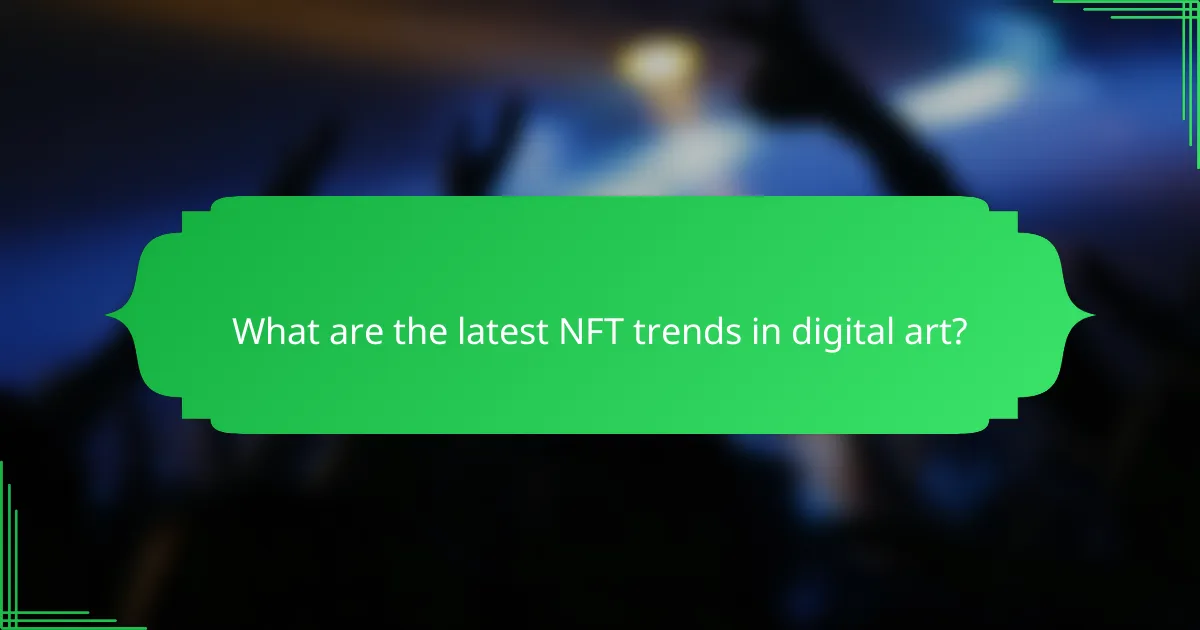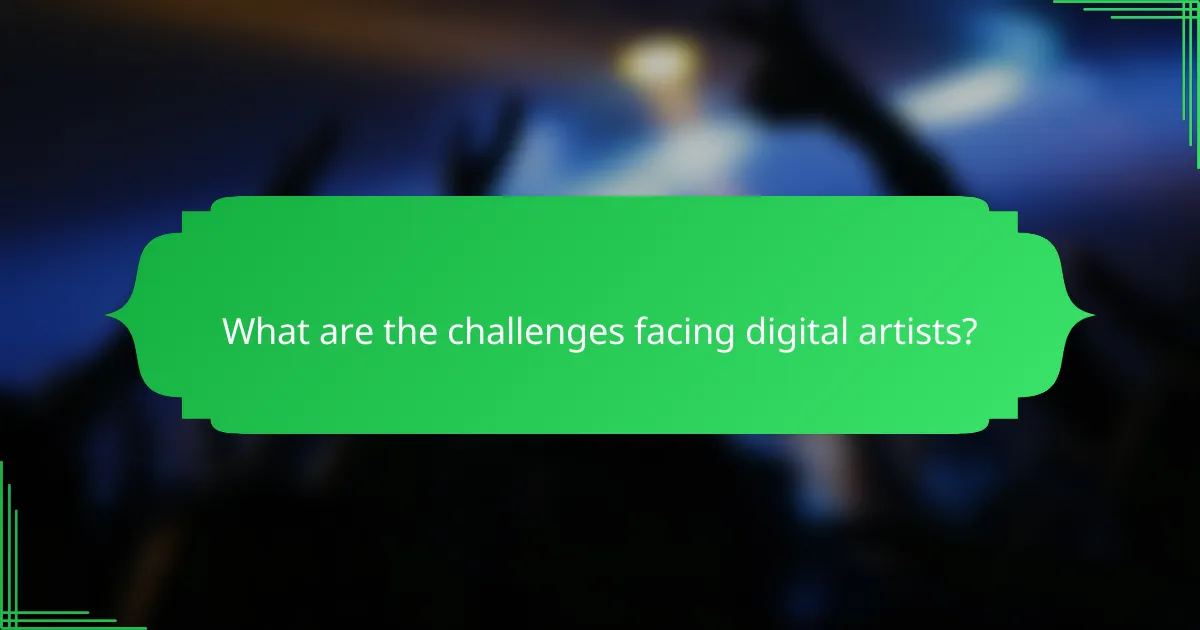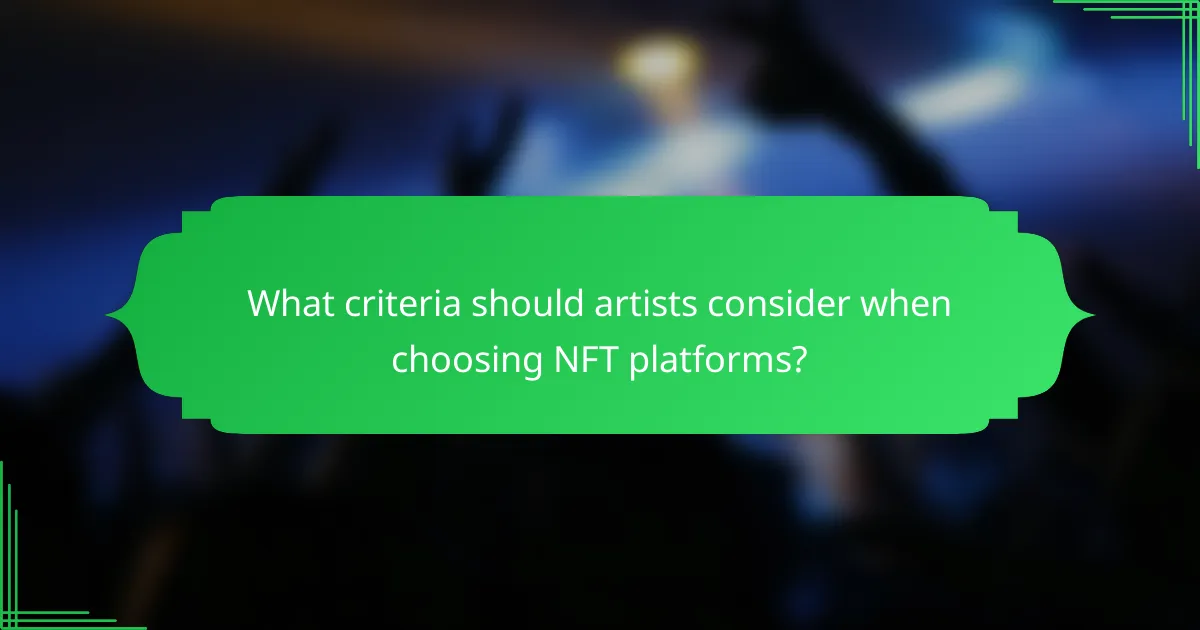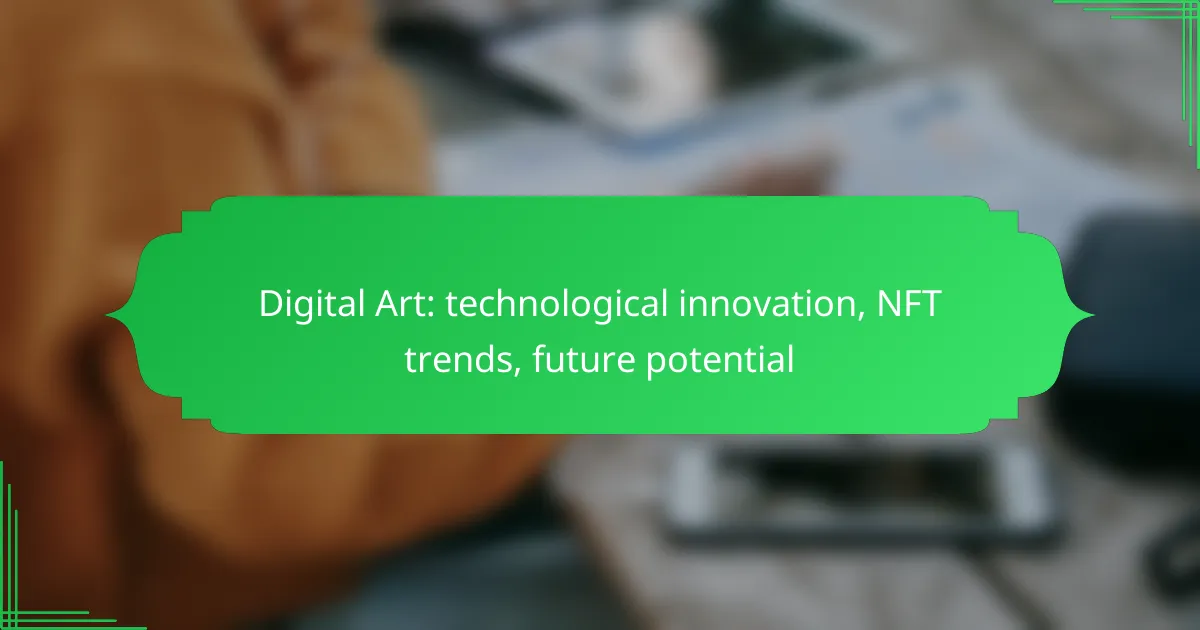Digital art is undergoing a transformative evolution driven by technological innovation, with artists harnessing tools like artificial intelligence and virtual reality to push creative boundaries. The rise of NFTs has further revolutionized the landscape, enabling artists to create unique digital assets that foster community engagement and offer new revenue opportunities. As these trends continue to develop, the future of digital art holds immense potential for both creators and audiences alike.

How is technology transforming digital art in the UK?
Technology is significantly reshaping digital art in the UK by introducing innovative tools and platforms that enhance creativity and accessibility. Artists are now leveraging advancements such as artificial intelligence, virtual reality, and augmented reality to create immersive and engaging experiences.
AI-generated art tools
AI-generated art tools are revolutionizing the creative process by allowing artists to generate unique pieces with minimal input. These tools use algorithms to analyze existing artworks and produce new compositions, enabling artists to explore styles and concepts they may not have considered. Popular platforms include DALL-E and Artbreeder, which offer user-friendly interfaces for both amateurs and professionals.
When using AI tools, artists should consider the balance between their own creativity and the output generated by the software. While AI can provide inspiration, relying solely on it may lead to a lack of personal touch in the artwork. It’s essential to experiment and integrate AI outputs with traditional techniques for a more authentic result.
Virtual reality experiences
Virtual reality (VR) experiences are transforming how audiences engage with digital art by creating immersive environments that allow viewers to interact with artworks in three dimensions. Platforms like Oculus and HTC Vive offer artists the ability to craft virtual galleries where users can navigate and experience art from different perspectives.
Artists interested in VR should focus on storytelling and user engagement to enhance the experience. Incorporating sound, movement, and interactive elements can make the artwork more compelling. However, it’s crucial to ensure that the technology used is accessible to the target audience, as not everyone may have access to high-end VR equipment.
Augmented reality applications
Augmented reality (AR) applications are bridging the gap between the physical and digital worlds, allowing users to view digital art overlaid on real environments through their smartphones or AR glasses. Tools like Adobe Aero and Artivive enable artists to create interactive experiences that can be viewed in public spaces or at home.
To effectively use AR, artists should consider the context in which their work will be viewed. Creating art that responds to the viewer’s environment can enhance the overall experience. Additionally, artists should be mindful of the technical requirements for AR applications, ensuring that their audience can easily access and engage with the content.

What are the latest NFT trends in digital art?
The latest NFT trends in digital art include a surge in community-driven projects, increased collaboration between artists and brands, and a focus on sustainability. Artists are leveraging NFTs to create unique digital assets that not only represent their work but also engage audiences through interactive experiences.
Top NFT marketplaces in the UK
In the UK, several NFT marketplaces have gained popularity among digital artists and collectors. Platforms like OpenSea, Rarible, and Foundation are leading the way, offering diverse options for buying, selling, and minting NFTs. Each platform has its own fee structure, typically ranging from 2.5% to 15% on sales, so it’s essential to compare them before choosing one.
Additionally, UK-specific platforms like Minted and Nifty Gateway cater to local artists and buyers, providing tailored experiences that highlight regional talent. These marketplaces often feature curated collections, making it easier for collectors to discover new artists.
Popular NFT artists and collections
Some of the most popular NFT artists include Beeple, Pak, and Grimes, each known for their unique styles and innovative approaches to digital art. Collections like Bored Ape Yacht Club and CryptoPunks have also made headlines, with some pieces selling for millions of dollars, showcasing the potential value of NFTs in the art world.
Emerging artists are also gaining traction, often collaborating with established names to create limited-edition pieces. This trend not only boosts visibility for new talent but also fosters a sense of community within the NFT space.
Impact of NFTs on traditional art sales
NFTs are significantly impacting traditional art sales by providing artists with new revenue streams and greater control over their work. Many artists are now able to sell directly to collectors without relying on galleries, which can take substantial commissions. This shift is democratizing the art market and allowing for more diverse voices to be heard.
However, the rise of NFTs has also sparked debates about authenticity and ownership. Traditional art institutions are beginning to adapt, with some galleries incorporating NFTs into their exhibitions and sales strategies. As the market evolves, both traditional and digital art sectors will likely continue to influence each other.

How can artists benefit from NFTs?
Artists can benefit from NFTs by creating unique digital assets that can be sold and traded, allowing for new revenue streams and enhanced visibility. By leveraging blockchain technology, artists can ensure authenticity and ownership, which can lead to increased value over time.
Revenue generation through royalties
NFTs enable artists to earn royalties on secondary sales, providing ongoing revenue beyond the initial sale. Typically, artists can set a percentage—often between 5% and 15%—to receive each time their work is resold on the marketplace.
This model contrasts with traditional art sales, where artists often miss out on profits from future transactions. By utilizing NFTs, artists can create a sustainable income model that rewards them as their work appreciates in value.
Building a global audience
Through NFTs, artists can reach a worldwide audience without the limitations of physical galleries. Online platforms allow creators to showcase their work to collectors from various countries, expanding their visibility and potential customer base.
Engaging with a global audience also opens opportunities for collaborations and partnerships, which can further enhance an artist’s profile and marketability. Social media and NFT marketplaces serve as effective tools for promoting artwork and connecting with fans across different regions.
Engagement with collectors
NFTs foster direct relationships between artists and collectors, allowing for personalized interactions and community building. Artists can communicate directly with their buyers, offering insights into their creative process and upcoming projects.
This engagement can lead to a loyal fan base, as collectors often appreciate the opportunity to support artists directly. Additionally, artists can offer exclusive content or experiences to their NFT holders, further enhancing collector investment and interest.

What are the challenges facing digital artists?
Digital artists encounter several challenges that can hinder their creative and commercial success. Key issues include market saturation, copyright concerns, and the environmental impact of blockchain technologies.
Market saturation
The digital art market has become increasingly crowded, making it difficult for individual artists to stand out. With countless creators sharing their work online, competition is fierce, and distinguishing oneself requires innovative approaches and effective marketing strategies.
Artists should focus on building a unique brand and engaging with their audience through social media and online platforms. Collaborations and niche targeting can also help in gaining visibility amidst the saturation.
Copyright issues
Copyright challenges are significant for digital artists, especially with the ease of reproducing and distributing digital content. Many artists struggle to protect their work from unauthorized use or theft, which can lead to lost revenue and diminished recognition.
To mitigate these risks, artists should consider registering their work with copyright offices and using watermarks or digital signatures. Understanding the legal landscape regarding copyright in their country can also provide better protection.
Environmental concerns of blockchain
The rise of NFTs has raised environmental concerns due to the energy-intensive processes associated with blockchain technology. Many artists are becoming aware that minting NFTs can contribute to carbon emissions, which may conflict with their values and those of their audience.
Artists can address these concerns by choosing eco-friendly blockchain platforms that utilize proof-of-stake mechanisms or by offsetting their carbon footprint through various initiatives. Staying informed about sustainable practices in the NFT space is essential for responsible engagement.

What criteria should artists consider when choosing NFT platforms?
Artists should evaluate NFT platforms based on fees, user experience, and community support to ensure they select the best fit for their work. Each of these factors can significantly impact the success and visibility of their digital art in the NFT marketplace.
Fees and commissions
When choosing an NFT platform, artists must consider the fees and commissions associated with selling their work. Platforms typically charge a percentage of the sale price, which can range from low single digits to over 10%. Additionally, there may be gas fees for transactions, especially on networks like Ethereum, which can vary widely based on network congestion.
Artists should compare the total costs across different platforms to understand their potential earnings. For instance, a platform with a lower commission might still incur higher transaction fees, affecting overall profitability.
User interface and experience
The user interface and overall experience of an NFT platform are crucial for artists, especially those new to the space. A clean, intuitive interface can simplify the process of minting and listing art, making it easier to navigate for both creators and buyers. Look for platforms that offer clear instructions and responsive design.
Additionally, consider the tools available for promoting your art. Some platforms provide built-in marketing features or analytics that can help artists track engagement and sales performance, enhancing their ability to connect with potential buyers.
Community and support
A strong community and reliable support can significantly enhance an artist’s experience on an NFT platform. Engaging with a vibrant community can provide networking opportunities, feedback, and collaboration possibilities. Look for platforms that host forums, social media groups, or events where artists can interact.
Moreover, effective customer support is vital for resolving issues quickly. Check for platforms that offer responsive support channels, such as live chat or dedicated help desks, to assist artists with any technical or transactional problems they may encounter.

What is the future potential of digital art and NFTs?
The future potential of digital art and NFTs lies in their ability to redefine ownership, accessibility, and creativity in the art world. As technology evolves, digital art is set to become more integrated into various platforms, enhancing its value and reach.
Integration with metaverse platforms
Digital art and NFTs are increasingly being integrated into metaverse platforms, creating immersive experiences for users. Artists can showcase their work in virtual galleries, allowing for global access and interaction with audiences in real-time.
This integration facilitates new revenue streams, as artists can sell virtual items or experiences directly to consumers. For instance, a digital painting could be displayed in a virtual space, where users can purchase a unique NFT version to own.
Emerging technologies in art creation
Emerging technologies such as augmented reality (AR), virtual reality (VR), and artificial intelligence (AI) are transforming the way digital art is created. These tools enable artists to experiment with new forms and techniques, expanding their creative possibilities.
For example, AI can assist in generating unique artworks based on specific inputs, while AR can overlay digital art onto the physical world, enhancing viewer engagement. Artists should consider how these technologies can complement their work and attract new audiences.
